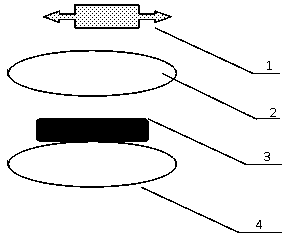Formaldehyde gas-sensing material, corresponding formaldehyde gas-sensing element and preparation method of element
A production method and formaldehyde gas technology, applied in the direction of material resistance, etc., can solve the problems of high working temperature, difficulty in large-scale production, and complicated production process of gas sensor components, and achieve the effects of low cost, fast induction, and good flexibility resistance
- Summary
- Abstract
- Description
- Claims
- Application Information
AI Technical Summary
Problems solved by technology
Method used
Image
Examples
Embodiment 1
[0038] (1) According to the ratio in the table, weigh each component to form a powder mixture:
[0039] Inorganic components SnO 2 In 2 o 3 WO 3 Pt PD CaO Content (wt%) 75 16 4 1 2 2 Particle size (nm) ≤80 ≤70 Median diameter (nm) ≤50 ≤50
[0040] Put the above 100 parts by mass of powder into 310 parts by mass of absolute ethanol solution, and stir with a stirrer at a speed of 200 r / min for 4 hours to obtain a uniformly mixed emulsion.
[0041] (2) Put the uniformly mixed emulsion into a low-temperature vacuum drying oven, and perform vacuum drying at 30°C to remove absolute ethanol.
[0042] (3) Weigh the inorganic powder and organic slurry carrier for gas-sensitive layer slurry according to the following ratio:
[0043] Based on 100 parts of dried inorganic powder, add 3.5 parts of hydrogenated castor oil, 43 parts of terpineol, 8.5 parts of polyvinyl butyral, and 6 parts of dibutyl phthalate, ...
Embodiment 2
[0047] (1) According to the ratio in the table, weigh each component to form a powder mixture:
[0048] Inorganic components SnO 2 In 2 o 3 WO 3 Pt PD CaO Content (wt%) 78 14 3 1.5 1.5 2 Particle size (nm) ≤80 ≤70 Median diameter (nm) ≤50 ≤50
[0049] Put 100 parts by mass of the mixture powder above into 310 parts by mass of anhydrous ethanol solution, and stir for 4 hours at a speed of 200 r / min with an electric stirrer to obtain a uniformly mixed emulsion.
[0050] Subsequent process steps are the same as in Example 1, and the formaldehyde gas sensor S2 is produced.
Embodiment 3
[0052] The preceding process steps are the same as in Example 1. In step (5), the laser sintering temperature is 520° C., and the sintering time is 0.16 h. After sintering, the required formaldehyde gas sensor S3 is obtained.
PUM
| Property | Measurement | Unit |
|---|---|---|
| particle diameter | aaaaa | aaaaa |
| particle size | aaaaa | aaaaa |
| particle diameter | aaaaa | aaaaa |
Abstract
Description
Claims
Application Information
 Login to View More
Login to View More - R&D
- Intellectual Property
- Life Sciences
- Materials
- Tech Scout
- Unparalleled Data Quality
- Higher Quality Content
- 60% Fewer Hallucinations
Browse by: Latest US Patents, China's latest patents, Technical Efficacy Thesaurus, Application Domain, Technology Topic, Popular Technical Reports.
© 2025 PatSnap. All rights reserved.Legal|Privacy policy|Modern Slavery Act Transparency Statement|Sitemap|About US| Contact US: help@patsnap.com

